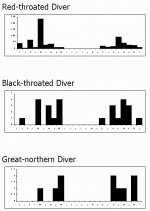Stephen Dunstan
Registered User
Yes there have been one or two 'inland' bird over the years, I just hadn't seen any of them so apologies if I implied there hadn't been any. The few inland divers in Lancs are just as likely to be the scarce / rare BTD and GND as RTD, when the latter are much more numerous on the coast.
The Pine Lake bird actually became very difficult late in its stay because it was commuting regularly to the sea!
Stephen.
The Pine Lake bird actually became very difficult late in its stay because it was commuting regularly to the sea!
Stephen.






